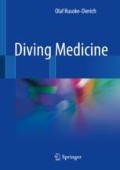Abstract
A variety of different life forms arose throughout evolution. An important aspect for survival was defence and food supply. Protection was provided by camouflage or by defensive mechanism. Some animals developed venom or poison, so they became unattractive as prey. Some fish have spines, which contain venom; some other animals have poison within the body to make them unattractive for consumption. Especially sick, weak animals or carrion are preferred prey. By this, nature on the one hand is cleaned up, and on the other hand, it guarantees “strong, healthy” animals to survive and reproduce. At the end of the food chain are predators like sharks, barracudas and humans who are benefiting from marine food sources. A variety of marine animals could harm divers by their venom, electrocution or biting. But mainly carelessness is putting divers at risk. Either unintentional touching of venomous fish or provocation of marine life is a major cause of injuries by marine animals. But even if divers behave prudently, injuries and envenomation may occur.
Access this chapter
Tax calculation will be finalised at checkout
Purchases are for personal use only
References
Australian Resuscitation Council – ARC Guideline 9.4.5. Envenomation—Jellyfish stings 2010.
Fenner PJ, Williamson JA, Burnett JW, et al. The “Irukandji syndrome” and acute pulmonary oedema. Med J Aust. 1988;149(3):150–6.
Halford ZA, Yu PYC, Likeman RK, Hawley-Molly JS, Bingham CT, Bingham JP. Cone Shell envenomation: epidemiology, pharmacology and medical care. Diving Hyperb Med. 2015;45(3):200–7.
Loten C, Scokes B, Worsley D, et al. A randomised controlled trial of hot water (45 °C) immersion versus ice packs for pain relief in blue bottle stings. Med J Aust. 2006;184:329–33.
Ramasamy S, Isbister GK, Seymour JE, Hodgson WC. The IN VITRO effects of two (CHIRONEX FLECKERI and CHIROPSALMUS sp.) venoms: efficacy of box jellyfish antivenom. Toxicon. 2003;41:703–11.
Suggested Reading
Antibiotic Expert Group Therapeutic Guidelines: Antibiotic. Version 14 Melbourne: Therapeutic Guidelines Ltd; 2010.
Auerbach PS. Marine envenomations. N Engl J Med. 1991;325(7):486–93.
Australian Resuscitation Council – ACR9.4.7. Envenomation – fish stings July 2014.
Resuscitation Council – ARC Guideline 9.4.1. Australien Snake Bite 2011.
Australian Resuscitation Council – ARC Guideline 9.4.1. Australien Snake Bite 2011.
Australian Resuscitation Council – ARC Guideline 9.4.8. Pressure Bandage Technique 2011.
C. Dangerous Marine Creatures: Field Guide For Medical Treatment. 2nd ed. 1995. 63–68, 75–79, 239–249.
Edmonds C. Dangerous Marine Creatures: Field Guide For Medical Treatment. 2nd ed. Flagstaff: Best Pub. Co.; 1995. p. 63–68, 75–79, 239–249.
Fenner PJ, Lewin M. Sublingual glyceryl trinitrate as prehospital treatment for hypertension in Irukandji syndrome. Med J Aust. 2003;179(11–12):655.
Friedman MA, Fleming LE, Fernandez M, Bienfang P, Schrank K, Dickey R, et al. Ciguatera fish poisoning: treatment, prevention and management. Mar Drugs. 2008;6(3):456–79.
Gwee MC, Gopalakrishnakone P, Yuen R, et al. A review of stonefish venoms and toxins. Pharmacol Ther. 1994;64(3):509–28.
Habermehl G. Gift-Tiere und ihre Waffen. 5th ed. Berlin: Springer; 1994.
Isbister GK, Kiernan MC. Neurotoxic marine poisoning. Lancet Neurol. 2005;4(4):219–28.
Lalwani K. Animal toxins: Scorpaenidae and stingrays. BJA: Br J Anaesth. 1995;75:247.
Mers D. Gifte im Riff, vol. 1989. Stuttgart: Wissentschaftliche Verlagsgesellschaft; 1989.
Moczydlowski EG. The molecular mystique of tetrodotoxin. Toxicon. 2013;63:165–83.
Morrow JD, Margolies GR, Rowland J. Evidence that histamine is the causative toxin of scombroid-fish poisoning. N Engl J Med. 1991;324(11):716–20.
Stommel EW, Watters MR. Marine Neurotoxins: Ingestible Toxins. Curr Treat Options Neurol. 2004;6(2):105–14.
Sun KO. Management of puffer fish poisoning. Br J Anaesth. 1995;75(4):500.
Tiong K. Irukandji syndrome, catecholamines, and mid-ventricular stress cardiomyopathy. Eur J Echocardiogr. 2009;10:334–6.
Watters MR, Stommel EW. Marine neurotoxins: Envenomations and contact toxins. Curr Treat Options Neurol. 2004;6:115–23.
Welfare P, Little M, Pereira P, Seymour J. An in-vitro examination of the effect of vinegar on discharged nematocysts of Chironex Fleckeri. Diving and hyperbaric medicine : the journal of the South Pacific Underwater Medicine Society. 2014;44(1):30–4.
Williamson JA, Fenner PJ, Burnett JW. Venomous and poisonous marine animals: medical and biological handbook. Sydney: U NEW SOUTH WALES P; 1996. p. 106–17, 374–87, 418–22
Winkel KD, Tibballs J, Molenaar P, Lambert G, Coles P, Ross-Smith M, Wiltshire C, Fenner PJ, Gershwin LA, Hawdon GM, et al. Cardiovascular actions of the venom from the Irukandji (CARUKIA BARNESI) jellyfish: effects in human, rat and guinea-pig tissues in vitro and in pigs IN VIVO. Clin Exp Pharmacol Physiol. 2005;32:777–88.
Author information
Authors and Affiliations
Rights and permissions
Copyright information
© 2018 Springer International Publishing AG, part of Springer Nature
About this chapter
Cite this chapter
Rusoke-Dierich, O. (2018). Venomous and Dangerous Marine Animals. In: Diving Medicine. Springer, Cham. https://doi.org/10.1007/978-3-319-73836-9_29
Download citation
DOI: https://doi.org/10.1007/978-3-319-73836-9_29
Published:
Publisher Name: Springer, Cham
Print ISBN: 978-3-319-73835-2
Online ISBN: 978-3-319-73836-9
eBook Packages: MedicineMedicine (R0)

